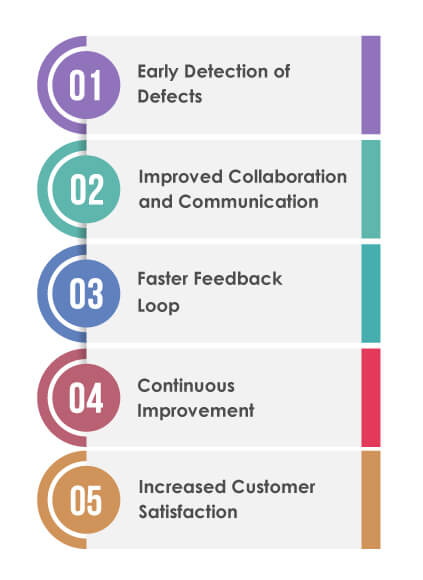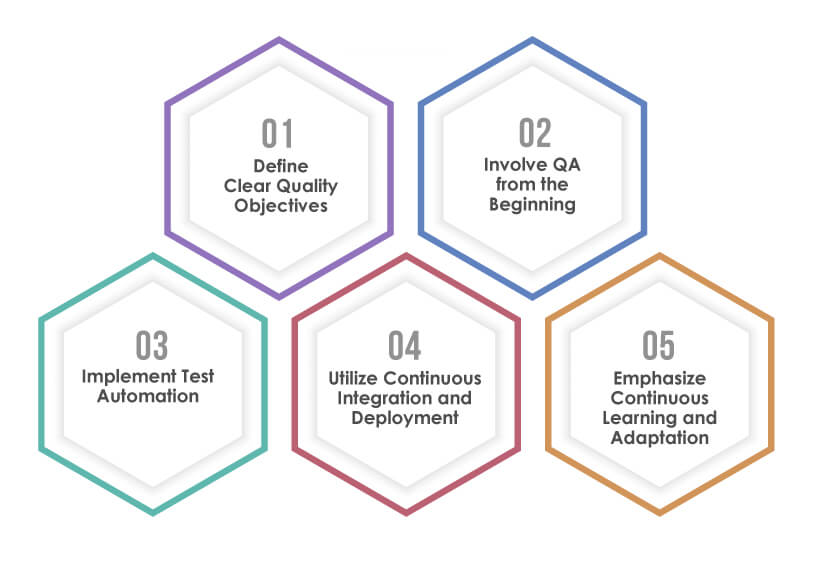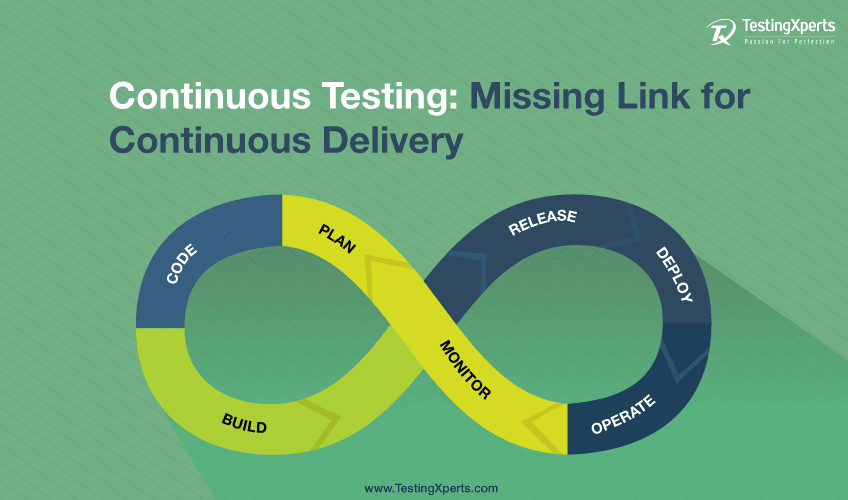Agile methodologies have gained immense popularity in today’s fast-paced software development landscape because they deliver high-quality products quickly. According to a survey by VersionOne, 97% of organizations practice Agile in some form. Within this dynamic framework, Quality Assurance (QA) in Agile development ensures that software meets the highest quality standards while aligning with customer expectations. A Consortium for IT Software Quality study found that organizations with strong QA practices experience 25% fewer defects in production.
Quality Assurance is critical in ensuring the software meets the desired quality standards and fulfills customer expectations. In an Agile environment, QA teams collaborate closely with developers, product owners, and other stakeholders throughout the development lifecycle to provide early feedback, detect defects, and maintain the overall quality of the software.
Role of QA process in Agile Development

Agile development is an iterative and collaborative software development approach focusing on flexibility, adaptability, and customer collaboration. Unlike traditional waterfall methodologies, where requirements are fixed, and development occurs in sequential phases, Agile methodologies embrace change and encourage continuous feedback and improvement throughout the development lifecycle.
Quality assurance (QA) is critical in Agile development by ensuring the software meets the defined quality standards and satisfies customer expectations. In an Agile environment, QA is not considered a separate phase that occurs after development but is an integral part of the entire software development lifecycle.
QA’s involvement begins right from the sprint planning phase, where they actively participate in discussions to understand the user stories and acceptance criteria. This early involvement enables QA professionals to provide valuable inputs regarding testability and identify potential quality risks. By collaborating closely with the development team, QA professionals gain a deep understanding of the software’s functionality, which allows them to design comprehensive test plans and strategies.
Furthermore, QA professionals contribute to the continuous improvement of the development process by actively participating in Agile retrospectives. These retrospectives provide an opportunity to reflect on the team’s performance, identify areas for improvement, and make adjustments to the QA process to enhance overall efficiency and effectiveness.
Benefits of Setting QA Process in an Agile Environment

In an Agile development environment, establishing a robust QA process brings many benefits that contribute to the overall success of software development projects. By integrating QA activities seamlessly into the Agile workflow, organizations can achieve the following:
Early Detection of Defects
One of the key advantages of incorporating a QA process in Agile development is the early detection of defects. In traditional software development approaches, testing is often performed towards the end of the development cycle, leaving limited time for identifying and resolving issues. However, Agile methodologies advocate for iterative testing throughout the entire development process. By involving QA professionals from the early stages, such as sprint planning and user story refinement, potential quality risks and testability challenges can be identified proactively. This allows QA teams to design comprehensive test plans and execute various testing activities, such as functional testing, regression testing, and integration testing, early on. The result is the early detection of defects, enabling swift resolution and preventing the accumulation of issues that could impact the final product.
Improved Collaboration and Communication
Setting up a QA process in an Agile environment promotes improved collaboration and communication among team members. Agile methodologies emphasize cross-functional teams working together towards a common goal. In this context, QA professionals actively collaborate with developers, product owners, and other stakeholders throughout the development lifecycle.
QA professionals contribute to discussions during sprint planning, ensuring a shared understanding of user stories and acceptance criteria. They work closely with developers, providing timely feedback on code quality and potential defects. By engaging in continuous communication, QA professionals and developers can address issues promptly, resulting in faster bug resolution and improved overall software quality.
Furthermore, QA professionals act as a bridge between technical and non-technical stakeholders. They are crucial in translating technical concepts and test results into clear, concise information that the entire team can easily understand. This promotes effective communication, aligns expectations, and enhances the overall efficiency of the Agile development process.
Faster Feedback Loop
In Agile development, a fast feedback loop is essential to ensure rapid iteration and course correction. QA teams are vital in providing timely feedback on the software’s functionality, usability, and performance. By continuously testing the product and giving feedback during each sprint, QA professionals enable developers to promptly identify and rectify any issues.
The faster feedback loop facilitated by the QA process helps teams avoid the pitfalls of delayed feedback, which can lead to higher costs and time-consuming rework. Early identification of defects and immediate feedback allows Agile teams to address issues with more agility and cost-effectively. This accelerates the overall development cycle and enables faster time-to-market for the product.
Continuous Improvement
Agile development methodologies prioritize continuous improvement, and the integration of a QA process aligns perfectly with this mindset. QA teams actively participate in Agile retrospectives, where the team reflects on the sprint’s successes, challenges, and areas for improvement.
By sharing their insights and experiences, QA professionals contribute valuable input to drive continuous improvement efforts. They can suggest enhancements to the testing process, identify areas where test automation can be implemented, and propose strategies to optimize test coverage and efficiency.
Through the continuous improvement cycle, Agile teams can enhance their QA process, refine testing strategies, and implement best practices that ultimately lead to higher-quality software and increased productivity.
Increased Customer Satisfaction
The most significant benefit of establishing a QA process in an Agile environment is its ultimate impact on customer satisfaction. Agile methodologies inherently prioritize delivering value to customers in each sprint. Organizations can incorporate QA activities to ensure the software meets or exceeds customer functionality, usability, and quality expectations.
Early detection and resolution of defects, improved collaboration and communication, faster feedback loops, and continuous improvement efforts collectively contribute to a higher-quality product. This, in turn, leads to increased customer satisfaction, as customers receive software that aligns closely with their requirements and performs reliably.
Moreover, the iterative nature of Agile development allows for flexibility and adaptability to changing customer needs. QA teams continuously validate the software against evolving customer expectations, ensuring that any changes or updates are thoroughly tested and meet the required quality standards.
Best Practices for Setting QA Process in an Agile Environment

Implementing an effective quality assurance process in an Agile environment ensures high-quality software development. Organizations should implement best practices that promote efficiency, collaboration, and continuous improvement to optimize the QA process within Agile methodologies:
Define Clear Quality Objectives
Clear quality objectives serve as a roadmap for the QA process in an Agile environment. These objectives should align with the overall project goals and customer expectations. By defining specific quality metrics, such as defect density, test coverage, and customer satisfaction levels, organizations can set measurable targets for the QA process.
When quality objectives are well-defined, QA teams can focus on achieving those targets throughout the Agile development lifecycle. This clarity provides a shared understanding of what constitutes quality and enables teams to proactively work towards meeting those objectives. Regular monitoring and reporting on these metrics help stakeholders assess the effectiveness of the QA process and make informed decisions for continuous improvement.
Involve QA from the Beginning
It is essential to involve QA professionals from the project’s beginning to maximize QA’s benefits in an Agile environment. By including QA representatives in sprint planning, user story refinement, and acceptance criteria discussions, organizations can leverage their expertise to ensure testability, identify potential risks, and provide valuable test planning and strategy input.
Early involvement of QA professionals also facilitates effective collaboration and communication between team members. By fostering a collaborative environment, teams can proactively address quality concerns, clarify requirements, and align expectations. This early engagement empowers QA professionals to design comprehensive test plans and execute testing activities in parallel with development, ensuring the delivery of high-quality software.
Implement Test Automation
Test automation is a critical practice that significantly enhances the efficiency and effectiveness of the QA process in an Agile environment. Automated tests can be executed rapidly and repeatedly, allowing quick feedback on software functionality and regression issues.
Organizations can free up QA resources to focus on more exploratory and critical testing activities by automating repetitive and time-consuming testing tasks, such as regression testing. Additionally, automated tests help ensure consistency and accuracy in test execution, minimizing human error.
To implement test automation successfully, organizations should identify suitable tools and frameworks that align with their technology stack and project requirements. Collaborative efforts between QA and development teams are vital for creating a robust and maintainable test automation suite that covers a broad range of test scenarios.
Utilize Continuous Integration and Deployment
Continuous Integration (CI) and Continuous Deployment (CD) practices are integral to Agile development and seamlessly integrate with the QA process. CI involves merging code changes frequently and automatically building and testing the application to identify integration issues and defects early on.
By integrating QA activities into the CI pipeline, organizations can run automated tests as part of the build process, ensuring that each code change undergoes rigorous testing. This promotes early detection of issues, faster bug resolution, and a more stable codebase.
CD extends CI by automatically deploying the successfully tested code to production or staging environments. This practice streamlines the delivery process, enabling rapid and frequent releases while maintaining high software quality.
Emphasize Continuous Learning and Adaptation
Continuous learning and adaptation are fundamental principles in Agile methodologies, and they apply equally to the QA process. To maximize the effectiveness of QA in an Agile environment, organizations should encourage a culture of continuous learning, where QA professionals stay updated with emerging technologies, industry best practices, and evolving testing methodologies.
Regular retrospectives allow the QA team to reflect on their processes, tools, and challenges. By identifying areas for improvement, teams can adapt their QA practices and incorporate lessons learned into future sprints.
Additionally, organizations should foster knowledge sharing and collaboration within the QA team and with other stakeholders. Conducting internal training sessions, hosting peer reviews, and encouraging cross-functional learning promotes a culture of continuous improvement and enhances the QA team’s collective expertise.
Conclusion
Implementing a well-defined Quality Assurance process in an Agile environment offers numerous benefits that can significantly enhance the overall development and delivery of software products. By integrating QA practices seamlessly into Agile methodologies, organizations can achieve greater efficiency, improved product quality, and increased customer satisfaction. Through continuous testing and feedback loops, QA professionals can catch and address potential issues before they escalate, thereby minimizing the chances of defects reaching the end-users.
How Can TestingXperts Help with QA Process in Agile Environment?

TestingXperts understand QA’s critical role in delivering high-quality software products quickly and efficiently. With our comprehensive understanding of Agile methodologies and a focus on collaboration, automation, and continuous improvement, we are well-equipped to help you achieve exceptional software quality while maintaining rapid development.
What Sets Our QA Process Apart?
Deep Understanding of Agile Methodologies:
Our team of experienced QA professionals has a comprehensive understanding of Agile methodologies, including Scrum, Kanban, and Lean. By aligning our QA process with Agile principles, we ensure seamless integration and collaboration with development teams throughout the entire software development lifecycle.
Early and Continuous Involvement:
Our QA professionals actively participate in sprint planning, user story refinement, and acceptance criteria discussions. Engaging early, we contribute valuable insights to ensure testability, identify potential risks, and set clear quality objectives. This early involvement fosters effective communication, alignment of expectations, and proactive resolution of quality-related issues.
Comprehensive Test Strategy:
Our QA process includes the development of a comprehensive test strategy tailored to the specific needs of each project. We employ a variety of testing techniques, including functional testing, regression testing, integration testing, and performance testing. Our experienced QA professionals design test plans that cover manual and automated testing to maximize test coverage while optimizing efficiency.
Test Automation Expertise:
We leverage industry-leading tools and frameworks to automate repetitive and time-consuming testing tasks, such as regression testing. Our test automation experts work closely with development teams to create robust and maintainable test suites that provide fast and reliable feedback on software quality. Automating tests accelerates the overall testing process, improves accuracy, and enables faster time-to-market.
Culture of Continuous Improvement:
Regular retrospectives provide a platform for reflecting on our processes, identifying areas for improvement, and implementing changes that enhance our QA practices. By staying aware of emerging technologies, industry trends, and customer needs, we continually evolve and optimize our approach.
Contact us today to discover how TestingXperts can help you achieve your software development goals in an Agile environment.
Discover more
Get in Touch
Stay Updated
Subscribe for more info




